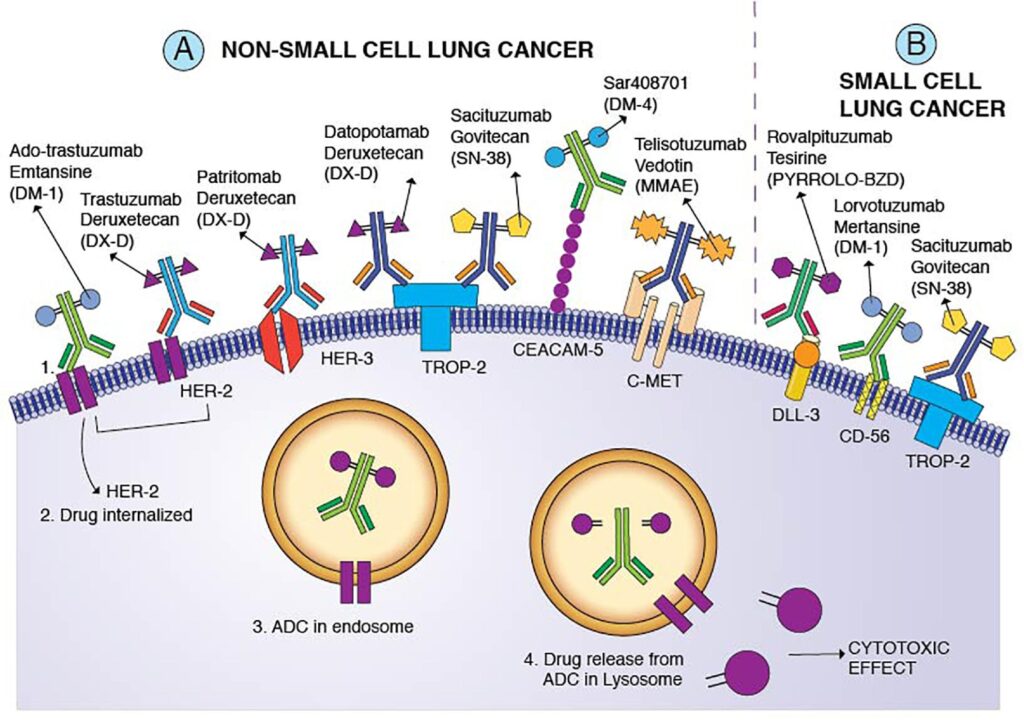Lung cancer treatment has undergone a revolution over the past two decades, transitioning from one-size-fits-all chemotherapy to highly personalized approaches such as targeted therapies and immunotherapy. These advancements have significantly improved survival rates and quality of life for patients. However, challenges like drug resistance, limited biomarkers, and toxicity remain obstacles. Looking ahead, the field is poised for further transformation as new therapies and technologies emerge. In this post, we’ll explore how lung cancer treatment has evolved, the current challenges, key trends shaping the future, and promising therapies in late-stage clinical trials or awaiting FDA approval.
Disclaimer: The lung cancer treatment landscape is evolving rapidly. While this post highlights key trends and therapies, it is not exhaustive and reflects information available as of March 2025.

How Lung Cancer Treatment Has Transformed Over the Past Two Decades
The introduction of targeted therapies and immunotherapy has been a game-changer in lung cancer care:
Targeted Therapies: Drugs like tyrosine kinase inhibitors (TKIs) target specific genetic mutations such as EGFR, ALK, ROS1, and KRAS G12C. These therapies have significantly improved outcomes for patients with driver mutations.
Immunotherapy: Immune checkpoint inhibitors (e.g., PD-1/PD-L1 inhibitors like pembrolizumab) have enabled durable responses in a subset of patients by reactivating the immune system to fight cancer.
Key milestones include:
- 2011: EGFR TKIs like erlotinib became standard for EGFR-mutant NSCLC.
- 2015: ALK inhibitors (e.g., alectinib) doubled progression-free survival compared to chemotherapy.
- 2020s: KRAS G12C inhibitors (sotorasib, adagrasib) broke the “undruggable” barrier.
These advancements have extended median survival for metastatic non-small cell lung cancer (NSCLC) from under a year to over 15 months in many cases.
Current Challenges in Lung Cancer Treatment
Despite significant progress, several challenges persist:
Drug Resistance: Tumors often develop resistance to targeted therapies through secondary mutations (e.g., EGFR T790M) or bypass signaling pathways. Similarly, immunotherapy resistance arises from immunosuppressive tumor microenvironments or upregulation of alternative immune checkpoints (e.g., LAG-3).
Toxicity: While precision therapies are more targeted than chemotherapy, they can still cause off-target effects. For example, antibody-drug conjugates (ADCs) and CAR T-cell therapies often lead to severe immune-related adverse events or myelosuppression.
Biomarker Limitations: Only a fraction of patients benefit from targeted therapy or immunotherapy due to limited actionable biomarkers like PD-L1 expression or tumor mutational burden (TMB).
Key Trends Shaping the Future of Lung Cancer Treatment
1. Next-Generation Targeted Therapies: Expanding the “Druggable” Universe
Targeted therapies are evolving to address resistance mechanisms and previously undruggable targets:
Pan-KRAS Inhibitors: Drugs that target multiple KRAS mutations (e.g., G12D, G12V) are entering clinical trials, building on the success of KRAS G12C inhibitors like sotorasib. Expect these next-gen inhibitors to expand treatment options for a broader range of patients with KRAS-driven cancers.
Molecular Glues and Protein Degradation: These innovative molecules degrade previously undruggable oncogenes like MYC by inducing protein proximity. While still early in development, they hold promise for addressing resistant tumors with high MYC expression.
Next-Gen ADCs: ADCs like datopotamab deruxtecan (TROP2-targeted) and patritumab deruxtecan (HER3-targeted) are designed to deliver potent chemotherapy payloads directly to cancer cells while minimizing off-target toxicity. These drugs are in phase III trials and could become new standards for advanced NSCLC.

2. Immunotherapy 2.0: Combination Strategies and New Modalities
Immunotherapy is evolving beyond single-agent checkpoint inhibitors to include combination strategies and novel modalities:
Bispecific Antibodies: These drugs simultaneously target two immune checkpoints (e.g., PD-1/TIGIT or PD-1/CTLA-4), aiming to enhance T-cell activation and overcome resistance seen with single-agent immunotherapy. Early trials show promising efficacy but require careful management of immune-related toxicities.
Neoadjuvant Immunotherapy: Combining checkpoint inhibitors with chemotherapy before surgery has shown significant promise in early-stage NSCLC by reducing recurrence risk and improving long-term survival outcomes.
Cancer Vaccines: Personalized mRNA vaccines targeting tumor-specific neoantigens are being tested in combination with checkpoint inhibitors to boost anti-tumor immunity in minimal residual disease settings.
3. Radiopharmaceuticals and AI Integration in Treatment and Diagnosis
Innovative technologies are also reshaping lung cancer care:
Targeted Radiopharmaceuticals: Actinium-225–based therapies (e.g., FPI-2265) deliver radiation directly to tumors via specific molecular targets like PSMA or somatostatin receptors. These agents are showing promise in chemo-resistant small cell lung cancer (SCLC).
AI-Powered Biomarker Discovery: Artificial intelligence is being used to analyze tumor biopsies, liquid biopsies, and imaging data to identify predictive biomarkers for treatment response earlier than traditional methods.
Promising Treatments in Phase III Clinical Trials or Awaiting FDA Approval
Here’s a list of some of the most exciting treatments currently in late-stage development:
| Therapy | Target/Mechanism | Phase (As of Early 2025) | Developer/Sponsor |
|---|---|---|---|
| Divarasib | KRAS G12C | III | Genentech |
| Datopotamab deruxtecan | TROP2 ADC | III | Daiichi Sankyo/AstraZeneca |
| Patritumab deruxtecan | HER3 ADC | III | Daiichi Sankyo/Merck |
| FPI-2265 | PSMA-targeted actinium-225 | II/III | Fusion Pharmaceuticals |
| RYZ101 | Somatostatin receptor-targeted | II/III | RayzeBio/Bristol Myers |
| BAY 3563254 | PSMA-targeted lutetium-177 | I/II | Bayer |
| AZD7789 | PD-1/TIM-3 bispecific antibody | II | AstraZeneca |
| LN-145 | Tumor-infiltrating lymphocyte | II | Iovance Biotherapeutics |
Conclusion
The future of lung cancer treatment lies in overcoming resistance mechanisms, minimizing toxicity, and leveraging cutting-edge technologies like AI and radiopharmaceuticals. With several promising therapies nearing regulatory approval—including next-gen ADCs, bispecific antibodies, and pan-KRAS inhibitors—patients can expect more personalized options that improve outcomes across all stages of disease.
While this post highlights key trends shaping the future of lung cancer care, it’s important to note that the field is advancing rapidly with new discoveries emerging every day. Stay tuned for updates as we continue to push the boundaries of what’s possible in lung cancer treatment!
Source: American Association for Cancer Research; Springer Nature; Annals of Translational Medicine; Labiotech.


